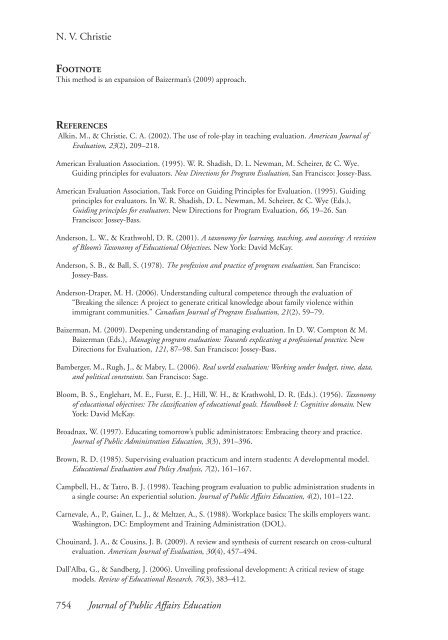An Interpersonal Skills Learning Taxonomy for Program Evaluation ...
An Interpersonal Skills Learning Taxonomy for Program Evaluation ...
An Interpersonal Skills Learning Taxonomy for Program Evaluation ...
Create successful ePaper yourself
Turn your PDF publications into a flip-book with our unique Google optimized e-Paper software.
N. V. ChristieFootnoteThis method is an expansion of Baizerman’s (2009) approach.ReferencesAlkin, M., & Christie, C. A. (2002). The use of role-play in teaching evaluation. American Journal of<strong>Evaluation</strong>, 23(2), 209–218.American <strong>Evaluation</strong> Association. (1995). W. R. Shadish, D. L. Newman, M. Scheirer, & C. Wye.Guiding principles <strong>for</strong> evaluators. New Directions <strong>for</strong> <strong>Program</strong> <strong>Evaluation</strong>, San Francisco: Jossey-Bass.American <strong>Evaluation</strong> Association, Task Force on Guiding Principles <strong>for</strong> <strong>Evaluation</strong>. (1995). Guidingprinciples <strong>for</strong> evaluators. In W. R. Shadish, D. L. Newman, M. Scheirer, & C. Wye (Eds.),Guiding principles <strong>for</strong> evaluators. New Directions <strong>for</strong> <strong>Program</strong> <strong>Evaluation</strong>, 66, 19–26. SanFrancisco: Jossey-Bass.<strong>An</strong>derson, L. W., & Krathwohl, D. R. (2001). A taxonomy <strong>for</strong> learning, teaching, and assessing: A revisionof Bloom’s <strong>Taxonomy</strong> of Educational Objectives. New York: David McKay.<strong>An</strong>derson, S. B., & Ball, S. (1978). The profession and practice of program evaluation. San Francisco:Jossey-Bass.<strong>An</strong>derson-Draper, M. H. (2006). Understanding cultural competence through the evaluation of“Breaking the silence: A project to generate critical knowledge about family violence withinimmigrant communities.” Canadian Journal of <strong>Program</strong> <strong>Evaluation</strong>, 21(2), 59–79.Baizerman, M. (2009). Deepening understanding of managing evaluation. In D. W. Compton & M.Baizerman (Eds.), Managing program evaluation: Towards explicating a professional practice. NewDirections <strong>for</strong> <strong>Evaluation</strong>, 121, 87–98. San Francisco: Jossey-Bass.Bamberger, M., Rugh, J., & Mabry, L. (2006). Real world evaluation: Working under budget, time, data,and political constraints. San Francisco: Sage.Bloom, B. S., Englehart, M. E., Furst, E. J., Hill, W. H., & Krathwohl, D. R. (Eds.). (1956). <strong>Taxonomy</strong>of educational objectives: The classification of educational goals. Handbook I: Cognitive domain. NewYork: David McKay.Broadnax, W. (1997). Educating tomorrow’s public administrators: Embracing theory and practice.Journal of Public Administration Education, 3(3), 391–396.Brown, R. D. (1985). Supervising evaluation practicum and intern students: A developmental model.Educational <strong>Evaluation</strong> and Policy <strong>An</strong>alysis, 7(2), 161–167.Campbell, H., & Tatro, B. J. (1998). Teaching program evaluation to public administration students ina single course: <strong>An</strong> experiential solution. Journal of Public Affairs Education, 4(2), 101–122.Carnevale, A., P., Gainer, L. J., & Meltzer, A., S. (1988). Workplace basics: The skills employers want.Washington, DC: Employment and Training Administration (DOL).Chouinard, J. A., & Cousins, J. B. (2009). A review and synthesis of current research on cross-culturalevaluation. American Journal of <strong>Evaluation</strong>, 30(4), 457–494.Dall’Alba, G., & Sandberg, J. (2006). Unveiling professional development: A critical review of stagemodels. Review of Educational Research, 76(3), 383–412.754 Journal of Public Affairs Education
















